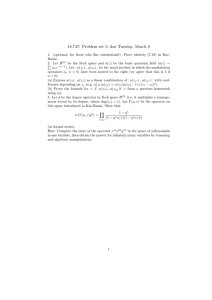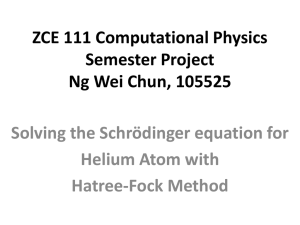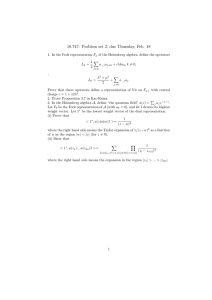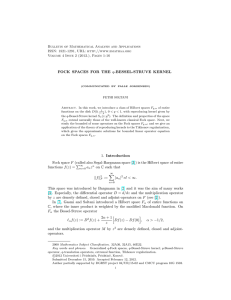Generalized chaos decomposition for L ´evy processes Michael Anshelevich February 20, 2004
advertisement
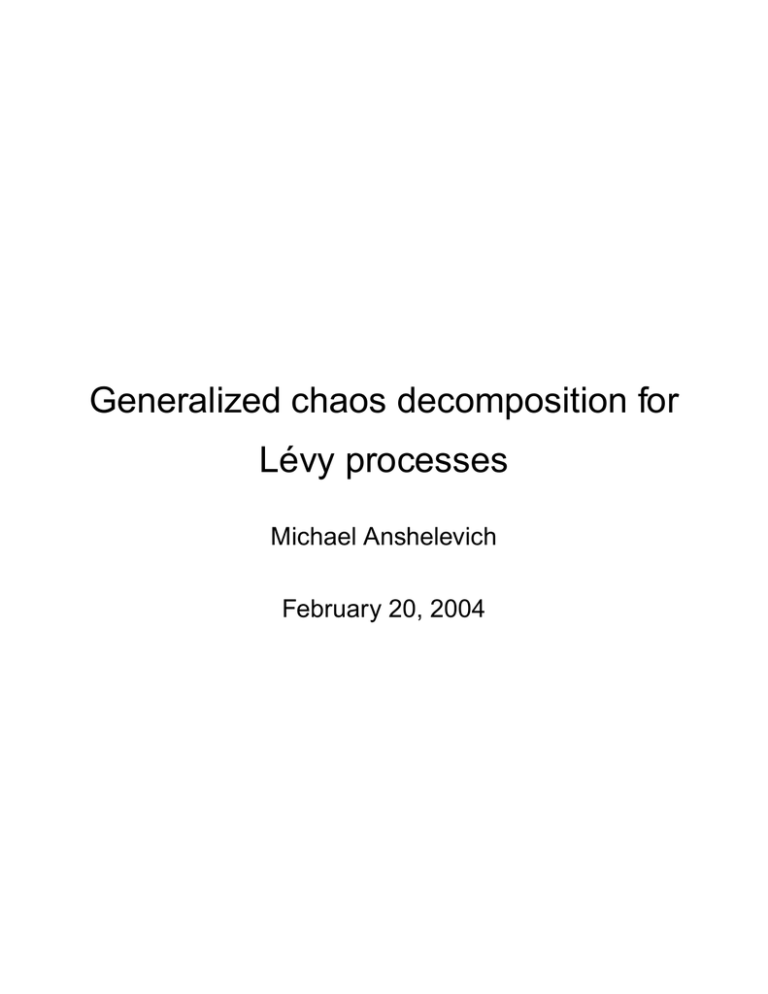
Generalized chaos decomposition for
Lévy processes
Michael Anshelevich
February 20, 2004
{B(t) : t ∈ [0, ∞)} = Brownian motion, gaussian process with independent stationary increments.
On a probability space (Λ, Σ, P ) with Σ generated by
{B(t)}.
“Functionals” of {B(t)}: B(1)2+B(2), max1≤t≤2 B(t),
etc.
Square-integrable functionals: elements
F ∈ L2(Λ, Σ, P ).
1
Theorem. (Wiener?) Any such F can be written as a
multiple stochastic integral
F =
∞ Z
X
n=0
∞ Z t1
Z
···
0
0
tn−1
fn(t1 , t2 , . . . , tn)dB(t1 )dB(t2 ) . . . dB(tn),
0
⊗n).
where fn ∈ L2(Rn
+ , dx
Equivalently,
F =
∞ Z
X
n=0 Dn
fn(t1, . . . , tn) dB(t1) . . . dB(tn)
for fn ∈ L2(Dn, dx⊗n), where
Dn = {(x1, x2, . . . , xn) : x1 > x2 > . . . > xn > 0} .
True for the (compensated) Poisson process, not true for
any other Lévy process (Emery, Dermoune).
2
Multiple Wiener-Itô stochastic integrals: for an indicator
function
f (t1, . . . , tn) = 1[a1,b1)×...×[an,bn)(t1, t2, . . . , tn)
for [a1, b1), . . . , [an, bn) disjoint intervals,
Z
f (t1, . . . , tn) dB(t1) . . . dB(tn)
= B(b1) − B(a1) . . . B(bn) − B(an) .
Extend to simple functions in L2(Dn, dx⊗n) by linearity.
They are dense. Extend to all of L2(Dn, dx⊗n) using the
Itô isometry:
E
Z
f dB(t1) . . . dB(tn)
Z
g dB(s1) . . . dB(sn)
= hf, giD
=
Z
Dn
f (x1, . . . , xn)g(x1, . . . , xn) dx1 . . . dxn.
Here E is the expectation,
E [F ] =
Z
Λ
F (ω)dP (ω).
3
A Lévy process: a process {X(t) : t ∈ [0, ∞)} with stationary independent increments.
µt = distribution of X(t). Assume X(t) centered and all
the moments of µt finite. Then
log F (µt)(θ) = t
1
(eiθx − 1 − iθx) 2 dτ (x)
x
R
Z
(Kolmogorov representation) where F = Fourier transform, τ = canonical measure of the process.
Assume τ has finite moments
mk (τ ) =
Z
xk dτ (x) < ∞
R
and even finite exponential moments
Z
eλx dτ (x) < ∞
R
for some λ.
4
Note: for scalar-valued measures,
example for the Brownian motion
Z t
0
R
dXdX = 0, but for
dX(s)dX(s) = t
(law of large numbers).
So let
∆n(t) =
Z t
0
(dX(s))n.
be the diagonal measures of the process. Again assume
Σ generated by {X(t)}. Then any F ∈ L2(Λ, Σ, P ) has
a representation
F =
∞ XZ
X
f~ud∆u(1)d∆u(2) . . . d∆u(n).
n=0 ~
u
(Nualart, Schoutens ’00).
5
Consider the algebra A generated by {B(t)} with the
inner product
hF, Gi = E [F G] .
Its completion is a Hilbert space isomorphic to
L2(Λ, Σ, P ). Denote it by L2(A, E).
So the Itô isometry is
∼ L2(A, E).
L2(Dn, dx⊗n) ,→ L2(Λ, Σ, P ) =
6
Denote H = L2(R+, dx).
⊗n)
H ⊗n = H ⊗ H ⊗ . . . ⊗ H = L2(Rn
+ , dx
is the “n-particle space.”
Falg(H) =
∞
M
H ⊗n
n=0
= (CΩ) ⊕ H ⊕ H ⊗2 ⊕ H ⊗3 ⊕ . . .
is the algebraic Fock space. Here Ω = vacuum vector.
7
On Falg(H) define the inner product: for f ∈ H ⊗n, g ∈
H ⊗k
X
hf, gi = δnk
σ∈Sym(n)
Z
Rn
f (t1, . . . , tn)g(tσ(1), . . . , tσ(n)) dt1 . . . dtn,
where Sym(n) is the permutation group. Quotienting out
by the tensors of length 0 and completing, get the symmetric Fock space Fs(H).
Note that for f, g ∈ L2(Dn, dx⊗n),
hf, gi =
Z
Dn
f (t1, . . . , tn)g(t1, . . . , tn) dt1 . . . dtn,
∼ L2(D , dx⊗n).
so Hs⊗n =
n
8
For f ∈ L2(R+, dx), g ∈ L2(Dn, dx⊗n), define creation
and annihilation operators on Fs(H) by
a∗(f )(g)(x0, x1, . . . , xn) = f (x0)g(x1, . . . , xn),
a(f )(g)(x1, x2, . . . , xn−1)
=
n Z
X
k=1 R+
f (xk )g(x1, . . . , xn) dxk .
a(f ) and a∗(f ) are adjoints of each other.
Let
a(t) = a(1[0,t)),
a∗(t) = a∗(1[0,t)),
X(t) = a(t) + a∗(t).
Define the expectation (state)
ϕ [A] = hΩ, AΩi .
9
{X(t)}t∈[0,∞) is a stochastic process. In fact it is the
Brownian motion, in the sense that all of its correlations
with respect to the state ϕ are the same as for the Brownian motion.
ϕ [X(t1)X(t2) . . . X(tn)] = E [B(t1)B(t2) . . . B(tn)] .
In particular, for A the algebra generated by {X(t)},
∼ L2(Λ, Σ, P ).
L2(A, ϕ) =
In fact: X(t)’s commute! So the C∗-algebra generated
by {X(t) : t ∈ [0, ∞)} is commutative, by the GelfandNaimark theorem isomorphic to some C(Λ). State ϕ a
state on C(Λ), so induces a measure P , which is gaussian.
10
Ω = cyclic and separating vector for A. Therefore
∼ F (H).
L2(A, ϕ) =
s
The isomorphism is
A 3 A 7→ AΩ ∈ Fs(H).
(1)
The Fock space has a natural grading = chaos decomposition. It remains to note that the inverse map to (1)
is
Hs⊗n = L2(Dn, dx⊗n) 3 f
f 7→
Z
f dB(t1)dB(t2) . . . dB(tn).
11
Thus the decomposition
Fs(H) 3 F =
∞
X
fn
n=0
translates into
L2(Λ, Σ, P ) 3 F =
∞ Z
X
fndB(t1)dB(t2) . . . dB(tn),
n=0
with
kF k2
2=
∞
X
kfnk2
2
n=0
and fn ∈ L2(Dn, dx⊗n).
12
F OCK
SPACE REPRESENTATION FOR
L ÉVY
PROCESSES .
Will do for compound Poisson processes,
log F (µt)(θ) = t
Z
(eiθx − 1)dν(x).
R
Roughly, dν(x) = x12 dτ (x). Only do this because the
notation is easier.
Let V = L2(R, ν) and
H = L2(R+, dx) ⊗ V
= L2(R+, dx) ⊗ L2(R, ν) = L2(R+ × R, dx ⊗ ν).
Define Fs(H). For x the independent variable in L2(R, ν),
1[0,t) ⊗ x ∈ H, so define
a(t) = a(1[0,t) ⊗ x)
a∗(t) = a∗(1[0,t) ⊗ x)
as before.
13
Also, for f ∈ H and g ∈ H ⊗n, define the operator a0(f )
on Falg(H) by
a0(f )(g)(x1, . . . , xn) =
n
X
f (xk )g(x1, . . . , xn).
k=1
Define
a0(t) = a0(1[0,t) ⊗ x).
Lemma. a0(t) is an essentially self-adjoint operator with
a dense domain of analytic vectors.
Finally, let
X(t) = pt(x) = a(t) + a∗(t) + a0(t).
Proposition. The correlations of {X(t)} are the same
as those of the Lévy process with the Lévy measure ν.
14
Again, let A be the algebra generated by {X(t)}.
Proposition. Ω is a cyclic and separating vector for A,
and
∼ L2(A, ϕ) =
∼ F (H).
L2(Λ, Σ, P ) =
s
But this time, the stochastic integrals
∞ Z
X
fndX(t1)dX(t2) . . . dX(tn) Ω
n=0
will only generate Fs(L2(R+, dx) ⊗ C), not the full
Fs(L2(R+, dx) ⊗ V ).
15
Fortunately,
Rt
Proposition. The diagonal measures 0(dX(t))k are
∆k (t) = pt(xk ) + mk (ν).
Denote by Yk (t) the centered version of ∆k (t),
Yk (t) = pt(xk ).
Now the inverse map Fs(H) → L2(A, ϕ), restricted to
L2(Dn, dx⊗n) ⊗ V ⊗n, is given by
u(1) u(2)
u(n)
x2
. . . xn )
Z
f ⊗ (x1
7→
f dYu(1)(t1)dYu(2)(t2) . . . dYu(n)(tn).
So every element in L2(Λ, Σ, P ) can be written as this
kind of stochastic integral.
16
n
o
To make the statement more precise, let Ŷk (t) be the
Gram-Schmidt orthogonalization of {Yk (t)} in L2(A, ϕ).
Note that Ŷk (t) = pt(Pk ), where {Pk } are the orthogonal polynomials with respect to ν.
For a multi-index ~
u, denote
H~u =
nZ
f dŶu(1)(t1)dŶu(2)(t2) . . . dŶu(n)(tn)) :
o
2
⊗n
f ∈ L (Dn, dx ) .
Lemma. These subspaces are orthogonal for different ~
u.
17
We conclude that any F ∈ L2(Λ, Σ, P ) has a unique
chaos decomposition
∞ XZ
X
F =
f~udŶu(1)(t1)dŶu(2)(t2) . . . dŶu(n)(tn),
n=0 ~
u
where
kF k2
2=
X
kf~uk2
2
~
u
and f~u ∈ L2(Dn, dx⊗n).
18
L ÉVY
PROCESSES ON A
q- DEFORMED
FULL
F OCK
SPACE
Let q ∈ (−1, 1). Again start with H = L2(R+, dx) ⊗ V ,
ξ ∈ V (“function x”), T an operator on V (“multiplication
operator by x”). Construct Falg(H).
But now define a new inner product
hξ1 ⊗ ξ2 ⊗ . . . ⊗ ξn, η1 ⊗ η2 ⊗ . . . ⊗ ηk iq
= δnk
X
D
E
D
E
i(σ)
ξσ(1), η1 . . . ξσ(n), ηn ,
q
σ∈Sym(n)
where i(σ) the number of inversions of the permutation
σ. (Bożejko, Speicher ’91) ⇒ this is positive definite.
Completing, get the q-Fock space Fq (H).
For q = 1, quotient out to the symmetric Fock space; for
q = −1, quotient out to the anti-symmetric Fock space;
for q = 0, get the full Fock space.
19
For ζ ∈ H, define creation and annihilation operators on
Fq (H) by
a∗(ζ)(η1 ⊗ . . . ⊗ ηn) = ζ ⊗ η1 ⊗ . . . ⊗ ηn,
a(ζ)(η1 ⊗ . . . ⊗ ηn)
=
n
X
q k−1 hζ, ηk i η1 ⊗ . . . ⊗ η̂k ⊗ . . . ⊗ ηn.
k=1
a(ζ) and a∗(ζ) are again adjoints of each other. More-
over,
a(ζ)a∗(η) − qa∗(η)a(ζ) = hζ, ηi Id.
Also, for S an operator on H, define the operator a0(S)
on Fq (H) by
a0(S)(η1 ⊗ . . . ⊗ ηn)
=
n
X
q k−1(Sηk ) ⊗ η1 ⊗ . . . ⊗ η̂k ⊗ . . . ⊗ ηn.
k=1
a0(t) is essentially self-adjoint.
20
Let
X(t) = a(t) + a∗(t) + a0(t)
Note: X(t)’s no longer commute, so get a “non-commutative stochastic process”. For example, without a0, get
the q-Brownian motion.
For A the algebra generated by {X(t)}, in the same way
as before get:
Any A ∈ L2(A, ϕ) has a unique chaos decomposition
A=
∞ XZ
X
f~udŶu(1)(t1)dŶu(2)(t2) . . . dŶu(n)(tn),
n=0 ~
u
⊗n) and
where f~u ∈ L2(Rn
,
dx
+
kAk2
2=
X
kf~uk2
2.
~
u
21
Some applications of q-Lévy processes.
• C OMBINATORICS : Linearization coefficients for
q-Hermite and q-Charlier polynomials, by using the
q-Brownian motion and the q-Poisson process.
• P ROBABILITY: Are these processes Markov? Yes
for q = 0 (processes with freely independent increments), yes for q-Brownian motion and for the qPoisson process. No otherwise.
• O PERATOR A LGEBRAS : What are the von Neumann
algebras they generate?
22
